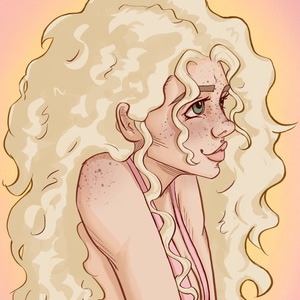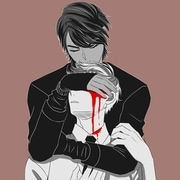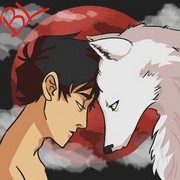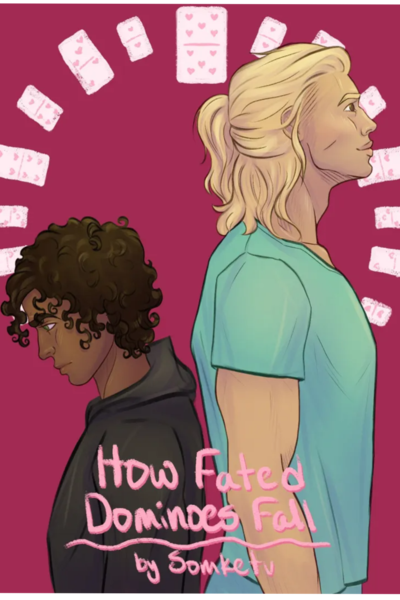TRIGGER WARNINGS:
Hospital Settings; Implications of Abuse; Broken Bones; Blood;
Gore; Implications of Sexual Assault; Physical Assault; Violence;
Depersonalization/Loss of Self; Explicit Sexual Content; Arranged Marriages;
Abusive/Neglectful Relationships; Chronic Illness; Ableism;
Parental Expectations; Parentification of a Minor; Grief;
Loss of a Loved One; Abandonment; Drug Abuse/Addiction;
Allusions to Child Abuse; Blatant Depictions of Abuse;
Explicit Scenes Depicting both Prejudice (toward gender and sexual
orientation) and Racism; Implications of Intimate Abuse;
Lying/Manipulation;
**Please Note: The below information is intended to read as if written in a medical journal or textbook. Thank you.
Despite the telepathic bond unlocked during puberty, it can still be exceptionally difficult to find your soulmate, so many people don't bother. Upon the completion of a bond with another, the telepathic bond dissolves and communication is severed. Bonding can only be done with one individual unless you have more than one fated mate, or should you share your fated mate with another, and it makes it to where only your mate(s) is able to sense your mating pheromones or send you into heat/rut. And though the initial introduction between unbonded fated mates results in the immediate trigger of a heat/rut cycle, bonded individuals are unable to be triggered nor sense the pheromones of others/have their pheromones sensed, even with their fated mate. Good bonds are for life, with separated mates experiencing a phenomenon called "mate withdrawal", in which extended periods of time without their mate can result in flu-like symptoms, malaise, despondency, lethargy, loss of appetite and occasionally even anorexia, extreme depression and irritability which can lead to episodes of mania and violence, and, in severe cases, dissociative anger and even death. Bonded mates rarely live long if their partner dies, however in the case of a bad bond (some examples being abuse, excessive mental turmoil, physical harm, etc) it is possible for your body to dissolve the bond slowly over time in order to protect itself. However, a person with a dissolved bond essentially becomes a beta-- no longer going into heat/rut or producing pheromones, and unable to form a new bond unless they somehow happen to find their fated mate. Many consider this to be a sort of biological safeguard against repeated abuse but it has never been confirmed. However, historically, there exists little to no evidence of abuse nor harmful relationships amongst fated mates, which solidifies the societal belief that a fated mate is the perfect partner.
Gender Traits observed within Secondary Genders are as follows:
Alphas- a secondary gender characterized by extreme virility and fecundity. On average, alphas tend to be physically stronger and more physically capable than other genders of their respective sexes, as well as possessing strong immune systems that allow for rare infection or illness and, statistically, they tend to have the least diagnoses of chronic illness among secondary genders, though this is not always the case. Alphas are also not any more inherently intelligent or capable than other secondary genders are, despite societal prejudice. They possess extremely sharp and thick canines in both the top and bottom rows of teeth, which are connected to scent glands within the palate of an alpha's mouth, and these canines become more prominent during an alpha's defense mode and during their rut. This occurs in order for an alpha to bond with their mate with the least amount of force, as an alpha's canines entering the scent gland of an omega allows for a direct infusion of their pheromones through their canines' connection to the alpha's own scent glands, resulting in what is called a "bond-mark"-- a permanent bond between alpha and omega that results in the mates being bound together in such a way as to be the only one able to sense the mating pheromones of the other (this pheromone exclusivity does not apply to defensive/offensive or soothing/protective pheromones secreted towards others), and unable to go into rut for anyone else. However, a bond-mark is only able to be created when both alpha and omega are in their rut and heat, respectively, though it remains unknown as to why this is the case. An alpha's rut is characterized by an increase in production of pheromones that is unable to be controlled, extreme irritability and occasionally even outbursts of aggression/violence towards perceived "threats" towards themselves or their mates, an extreme increase of possessiveness toward their mates, an extreme and uncontrollable lust/sexual drive, muscle aches, fever, occasional fatigue and excessive hunger. However, a rut is able to be mitigated by medications called "suppressants" and "pheromone blockers" that suppress the urges/symptoms of a rut and quell the production of pheromones, respectively. Ruts, on average, last anywhere from 24 to 72 hours, however ruts as long as a week have been reported, and occur once monthly, similar to a menstrual cycle. However a menstrual cycle and a rut are incapable of occurring simultaneously in those capable of menstruation. Alphas also possess what is called an "alpha's gaze"-- a slit pupilled version of their iris that is gold in color and is triggered both in rut and by a perceived threat not only to themselves, but also to their mate or children. An alpha's gaze is capable of a glare that, when combined with specialized pheromones similar to that of scent-secreting animals, creates a defensive mode capable of knocking opponents to their knees, and if the alpha is strong enough, even rendering them unconscious at times. An alpha's gaze is immediately triggered by the presence of danger to their mates, and this is increased ten-fold by the presence of an omega's shield. Historically, alphas were considered the protectors of their communities due to their increased strength alongside the presence of an alpha's gaze and have been praised/worshiped due to this warrior status. Though they do not retain this protective status in modern day, they do remain seen as the most important secondary gender, and have long been the most desired result of secondary gender testing, despite only representing about 12% of the world's population.
Betas- a secondary gender characterized by lack of specialized attributes. On average, betas are no more physically capable than other genders, nor are they capable of giving birth despite sex, as only those within this secondary gender who possess uteri are capable of reproduction. Betas do not experience a heat or rut, and are unable to produce pheromones. About 40% of the beta population is in fact reported to be unable to even sense pheromones, however those who do are able to be affected by the heat/rut of other genders. And even those unable to sense pheromones are able to be influenced by both an alpha's gaze and an omega's shield. Though unable to bond mark, betas do still possess fated mates, that are usually also betas, and still have the telepathic connection to their partner, though it does not dissolve when a different partner is chosen. Medication has been created that allows for the bond to be silenced, but it is unable to be dissolved. Betas are the most common secondary gender, representing about 75% of the world's population.
Omegas- a secondary gender characterized by extreme fertility, allowing for even males to possess qualities that allow for impregnation. On average, omegas tend to be smaller and more frail than other genders of their respective sexes, as well as possessing weaker immune systems that allow for an increase of illness and infection and, statistically, they tend to have the most diagnoses of chronic illness among secondary genders, though this is not always the case. Omegas are also not any more inherently unintelligent or incapable than other secondary genders are, despite societal prejudice. They possess scent glands in the nape of their neck that not only produce their defense mode, but are also the possessor of an omega's ability to bond with their mate-- an alpha puncturing an omega's nape with specialized canines only they possess allows for a direct infusion of an alpha's pheromones into the omega's scent gland, resulting in what is called a "bond-mark"-- a permanent bond between alpha and omega that results in the mates being bound together in such a way as to be the only one able to sense the mating pheromones of the other (this pheromone exclusivity does not apply to defensive/offensive or soothing/protective pheromones secreted towards others), and unable to go into heat for anyone else. However, a bond-mark is only able to be created when both alpha and omega are in their rut and heat, respectively, though it remains unknown as to why this is the case. An omega's heat is characterized by an increase in production of pheromones that is unable to be controlled, mood-swings that tend to, on average, lean towards depression or anxiety, an extreme increase of both possessiveness and neediness toward their mates, an extreme and uncontrollable lust/sexual drive, muscle aches, fever, extreme fatigue and nausea, and "nesting"-- a phenomenon specific to omegas that is characterized by the creation of a "nest" made of the possessions (primarily soft materials such as blankets, clothes, towels and/or stuffed animals/pillows) of their mate and/or other trusted loved ones in order to feel safe when otherwise on edge. An omega's nest is considered to be a sacred space and to disrupt their nesting, or to enter without permission, is akin to the most ultimate offense-- either transgression could permanently sour an omega's opinion of a person, and could even ruin their relationship with said person. Though it does not affect nesting, a heat is able to be mitigated by medications called "suppressants" and "pheromone blockers" that suppress the urges and symptoms of a heat and quell the production of pheromones, respectively. Heats, on average, last anywhere from 24 to 72 hours, however heats as long as two weeks have been reported, and occur once monthly, similar to a menstrual cycle. However a menstrual cycle and a heat are incapable of occurring simultaneously in those capable of menstruation. Omegas also possess what is called an "omega's allay"-- a type of biological response to anxiety, panic or turmoil both in themselves and in others that releases a special type of pheromone called "pacifiers", which possess specialized soothing qualities similar to medications given for the same ailments. Omegas also possess defensive modes similar to an alpha's gaze called an "omega's shield"-- this phenomenon is characterized by the creation of both an extremely high pitched sound intended to not only startle off attackers, but also to summon their mate, though it remains unknown how alphas are able to identify their partner's shield from the shields of other omegas, and the creation of two separate types of pheromones. These pheromones have extremely opposing purposes, as one is intended to function similar to the defensive mode of scent-secreting animals and repel potential attackers, while the other functions as an essential "SOS" signal to anyone nearby that may assist. When an omega's shield is activated in the vicinity of their mate, it results in an alpha's gaze being activated and extreme aggression being triggered in their partner, until the perceived threat has been eliminated, by any means necessary. Historically, omegas were considered to be detrimental to their communities due to perceived beliefs of omegas destroying the rationality of community protectors (aka alphas) through their heats and the activation of an omega's shield. Though alphas are no longer considered society's protectors, this prejudice towards omegas has remained and many omegas have reported experiencing excessive harassment during their lives as a result. Omegas are considered to be the least desirable secondary gender despite the importance of their fertility, and, simultaneously, have long been the most dreaded result of secondary gender testing, despite only representing about 12% of the world's population.












Comments (2)
See all